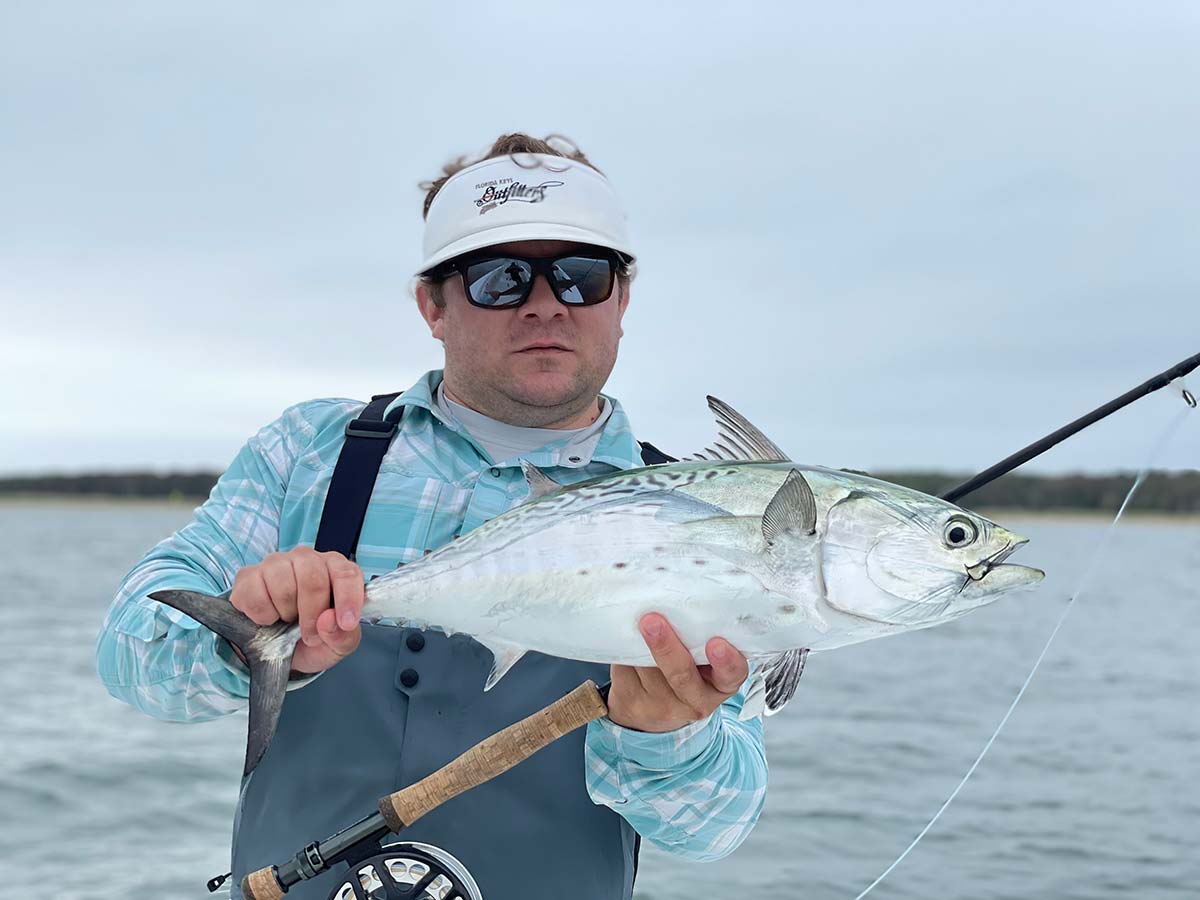
Shortening the curve for your first fly rod albie.
Many have said that little tunny, commonly called false albacore or “albies”, were made for the fly rod. In some respects this is very true: they eat tiny baitfish that are often better imitated by flies than lures. They’re the perfect size and power to battle on 8- to 10-weight fly rods.
A fly-rodder is handicapped in some respects though, too. With the massive popularity the species has gained over the last decade many are looking to catch their first little tunny on a fly rod. Whether you’re experienced targeting the species with spinning gear already or are simply a fly purist and have never fished for them, it can be intimidating to try to catch your first with the long rod. Luckily there are some ways to shorten the learning curve.
When I began targeting false albacore, it was mostly with blind faith and help from friends. Knowing the right people certainly helped me cut some corners. My frequent fishing partner Mark Alpert put me onto an albie the first time we tried, and the next season I made my first shore-based attempt and promptly caught more. It helped that Those years – 2016 and 2017 – featured very strong showings of the fish in my home waters of Eastern Long Island Sound. That is a contingency no angler can control. Sometimes the fish just aren’t there.
A Newcomer
False albacore are a relative newcomer to our waters in the grand scheme. Before the 1990s, “Bonito more or less dominated our showing of exotic fish in the Western Sound, with the occasional Spanish mackerel. Targeting albies with spinning gear didn’t become big until the 2000s” says Capt. Ian Devlin, whose home waters in Western Long Island Sound now get good runs of albies nearly every year. In that same timeframe of the 1990s, albies were invading waters to the east right as the initial boom of saltwater fly fishing in New England reached its peak.
Pioneering guides and anglers began honing tactics specifically for these hardtails in Montauk, Martha’s Vineyard, and Rhode Island, among other places. Now, albies are a staple in New England waters from the Cape south and west, generally showing first in Nantucket Sound in August and spreading to the rest of the Islands, the Cape, then progressively westward. By November they are on their way out with the last big shows often happening again on Nantucket as well as Long Island.
When I started targeting them in Eastern Connecticut, local pioneer Bob Hughes was still frequenting the rocks where he essentially started the game of targeting albies with a fly rod on foot. A lot has changed since the 90s, but the techniques developed by Hughes and others are still being utilized whether the anglers know where the strategies originated or not.
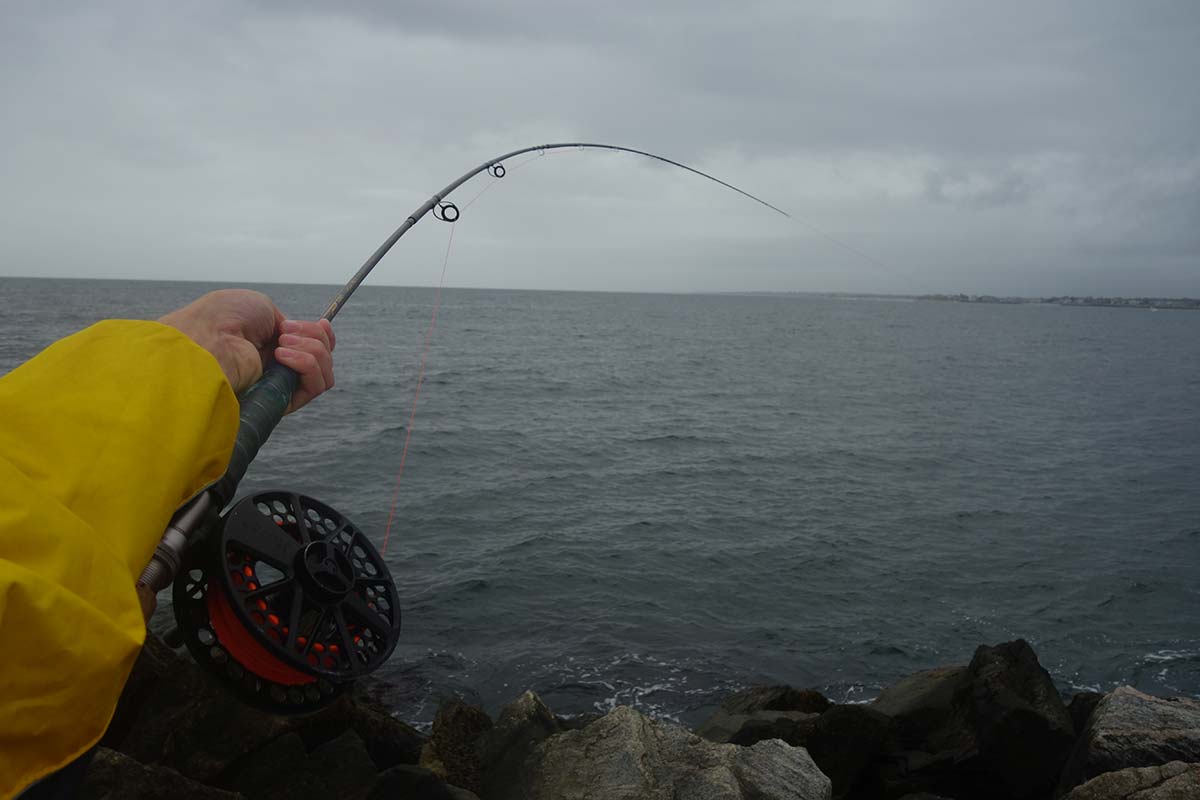
Rod, Reel & Line
The weapons in the albie addicts’ quiver start rather simply. Casting positions are often elevated, therefore a shorter fly rod creates a longer length of slack between the rod tip and the surface of the water that can hamper both action and hook setting. Longer is better because you can get your tip closer to the water when stripping and, with that reduced length of slack, your hooksets will be quicker and more effective. Rods in the 7- to 10-weight range are preferable. Reels need a reliable drag and at minimum 150 yards of backing capacity.
Since small flies are the norm, there’s little need for beefy, aggressive fly line tapers which by proxy also cause the same drag and slack issues when casting from the rocks or a high boat deck as short rods. The fly line choice is a bit of a source of complexity that can confuse some beginners. There is no singular solve-all fly line for albies, though some anglers have their preferences. My own is a floating line, and I’ve caught more on them than any other line. If you’ve come from a spinning background the affinity these fish have for skipping and skittering lures likely isn’t lost on you. You can only get a fly to skitter on a floating line. Plus, most fly anglers are already familiar with casting a floating line.
There are two other lines should be in every albie angler’s bag as well though: an intermediate and a full sinking line or “black line”. Covering that spectrum will put you on the right path. Leaders must be well tapered to ensure good turn-over and end in a relatively fine diameter tippet. My personal preference is a 9-foot leader tapering down to 20-pound test, though I often fish 15 or 12 if the fish become fickle. Many anglers revere fluorocarbon for hardtails, but nylon works just as well.
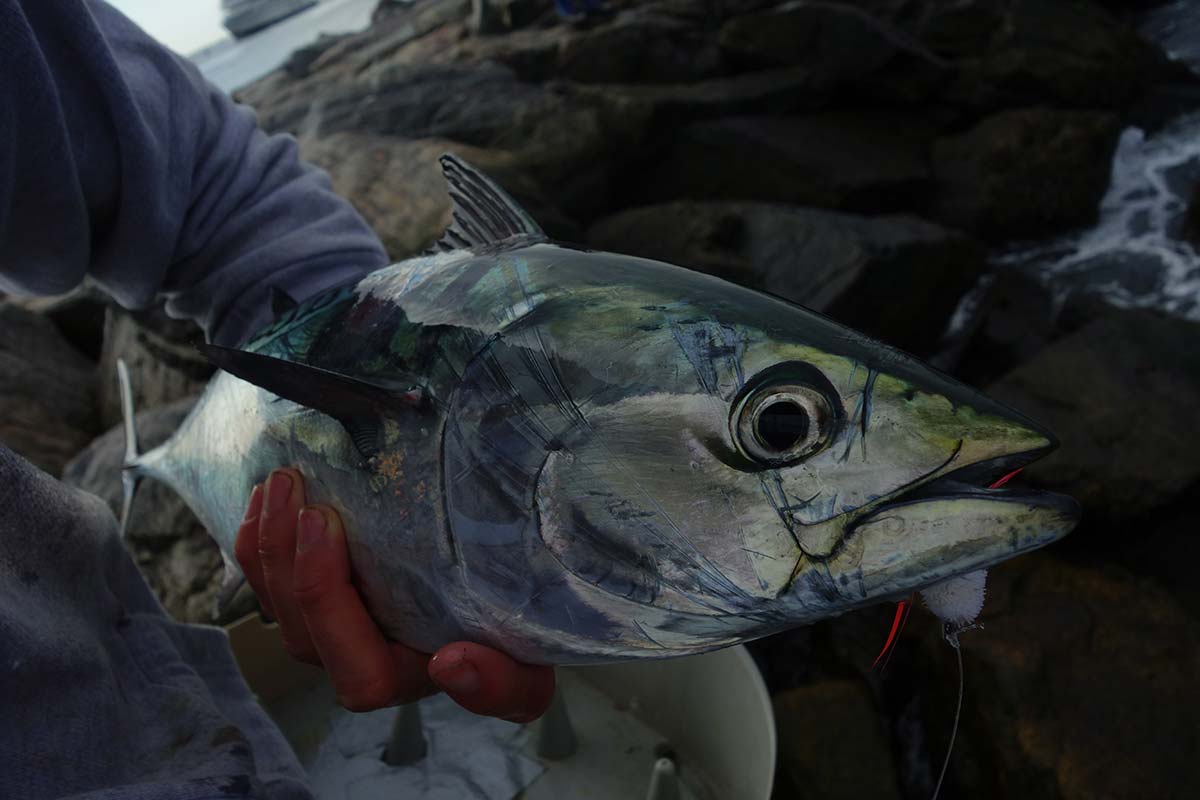
Three Flies
Fly selection can be complex as well, but there are basically three important categories: surface attractor, subsurface attractor, and imitative. To simplify things, start with one pattern in each category. For a floating attractor fly there is very little better than the floating, skittering action of a Gartside Gurgler fished on a fast strip or two hand retrieve. The significance of this fly in the hardtail game is lost on many but not on those who have experienced its deadliness. Like the skittering action of an Albie Snax worked along the surface, a gurgler drives these fish mad under a variety of conditions and is a vital tool. Sometimes though the fish simply don’t want to come to the top, and when an attractor is still useful, Dave Skok’s Albie Whore is hard to beat. It rarely fouls when tied correctly and has a pulsing action and big, visible profile that albies love.
On the imitative end, the bait that most demands an accurate representation often ends up being the bay anchovy. Small and dainty, the bay anchovy often results in the pickiest of albie feeds. A good representation is an EZ Body Minnow in tan over white with a little silver flash, tied just an inch-and-a-half long, or even less. A key part of the profile is a nice bulging pair of eyes, which stand out remarkably on the natural bait when viewed from below; the albie’s initial view. These small, imitative presentations should generally be fish more slowly and with a varied retrieve that pauses and pulses.
Once well-armed, it’s time to find the fish. For the land-based angler, proximity to depth is key to having albies running within fly casting range. From the rocks, natural or manmade jetty, having depths of 12 feet or more within 10 feet is paramount. A good current flow through most of the tide doesn’t hurt either. Beaches can fish well too, but they need a very steep gradient or just a very deep and prominent initial trough. Inlets and breachways are also key spots and should always be fished during incoming water. Popular spots include Rhode Island’s West Wall and the Vineyard’s Cape Poge Gut, but lesser-known shore-based hotspots dot the coastline.
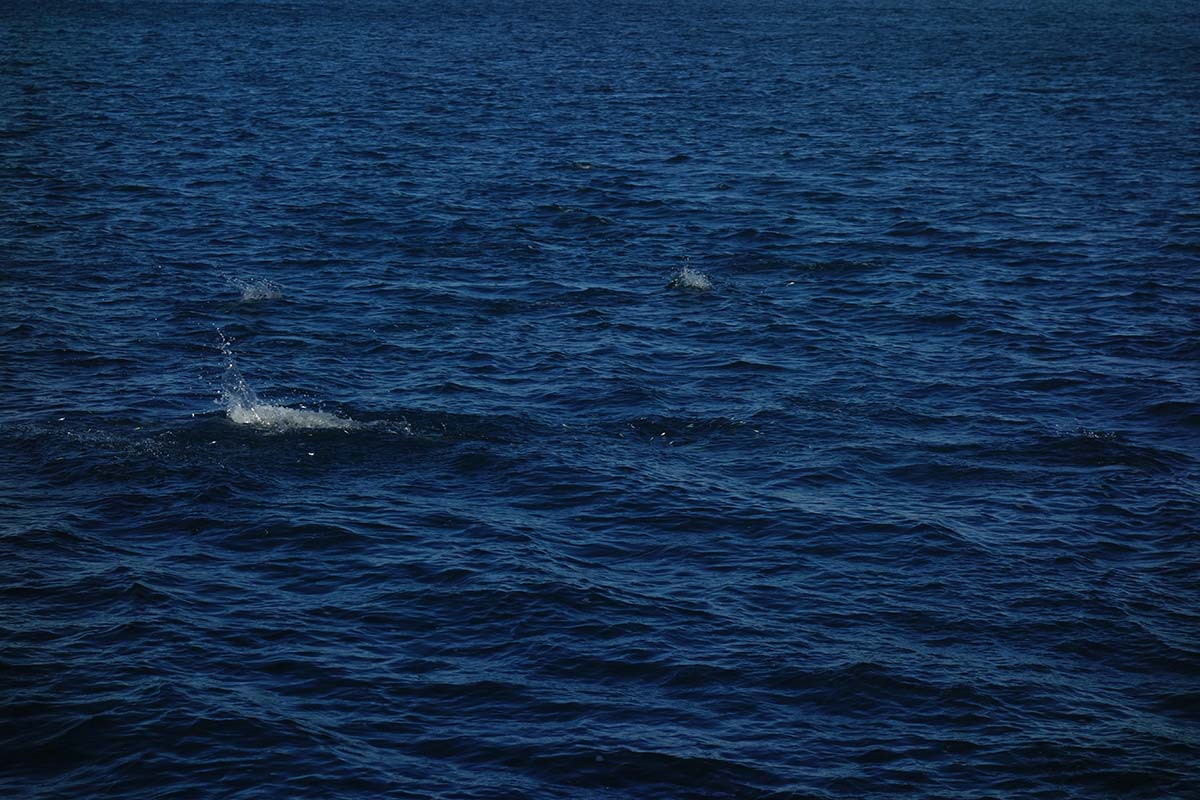
Tunny Terrain
Once you’ve found the right place, timing is everything. Wind can be the land-based angler’s best friend, especially one that’s in your face and generating a bit of chop. Too much wind can stir up the water and these fish don’t appreciate floating particulate, but a 10- to 15-mph headwind knocks the bait around and makes for good feeds. Such conditions combined with a good morning tide are sure to get the tunny feeding aggressively. Though the fish often show themselves with visually spectacular surface feeds, almost as often they are cruising out of sight. The best policy is to pick a rock and cast until you can cast no more. If the fish are surface feeding, it’s easy to get excited and try to fire right into the feeds. The fish are faster than you are though, and it is key to lead them in their direction of travel rather than firing right into (or soon to be behind) the breaks.
If you are trying to get your first from a boat, this principal is equally important. Watch the feeds intently and try to gauge a direction of travel, then maneuver the boat to where the albies are likely to pop up as they move. Don’t run full speed ahead right into the blitz, that just irritates everyone else around. Albies follow contours and current edges, even working the heads of rip lines almost like stripers do, so the best way to operate is to set up in line with the fish’s paths rather than chasing them around. When the magical moment comes and an albie finally eats the fly, strip until the line is tight and the fish is headed the other direction, then let the fish get itself on the reel. The rest of the fight is fairly straight forward. You will see your backing in short order.
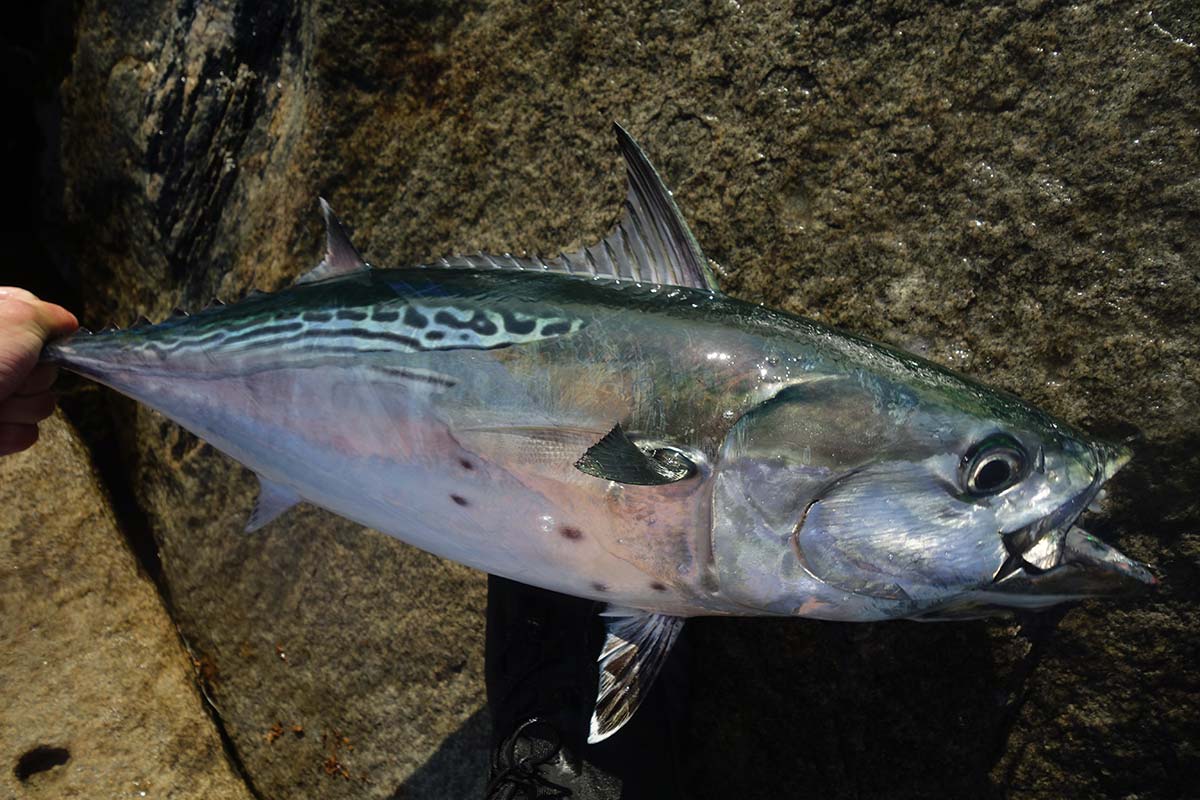
It’s A Mindset
If you’ve already caught the species on spinning gear you are on track to make quicker work of them with a fly rod, but it’s important to remember the differences in capability of each method. Alex Peru, inventor of the Albie Snax and wizard with both the fly rod and spinning alike, draws comparisons between the two games. “Basically, the fly allows you to fish more patiently which can be a great asset. You can’t fire out a cast at will or cover as much water… many times spin fishing can make you curse it as your lure is a county mile away off in the distance as a new group of fish breaks right next to you. The fly can give you patience to wait for the optimal shot”. Casting distance can be an asset when the fish are out of fly range, but a hindrance when they pop up at random right at your feet. If you are used to being able to land in a breaking school 250 feet away without a second thought, the fly rod will aggravate you.
The fly rod has other distinct advantages as well, as Alex points out with presentation: “You need a little thing to be lifelike and neutrally buoyant if you want to fish it at slower speeds, which is overlooked often…I mean, anytime someone with spinning gear designs a casting egg to present a fly, you know you’re doing something right”. He has a point. If you’re going to fish a fly anyway, why not fish it with a fly rod? The biggest advantage the fly-rodder has is delicately presenting a small, neutrally buoyant, very natural looking offering at ranges from 10 to 100 feet. Sure, there are days when the fish aren’t going to come within 100 feet, and for the shore-based angler who is used to being able to cast beyond that at will, switching to targeting albies with a fly rod may seem like an exceptional handicap. But there are almost as many days where the fly is just flat-out the correct presentation for the species, and there’s nothing quite like the sound of that backing singing through the guides as your first hardtail on the fly makes its initial insane run. Your first very likely won’t be your last.



